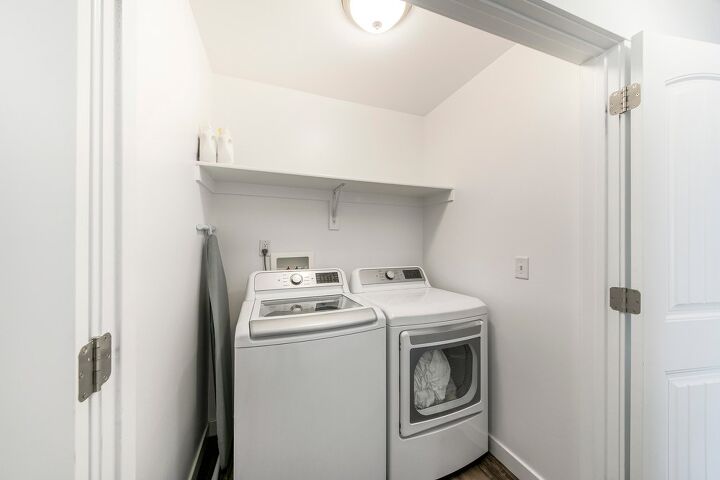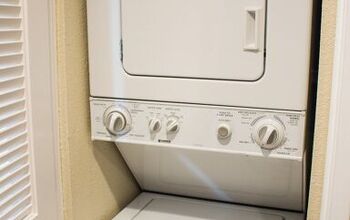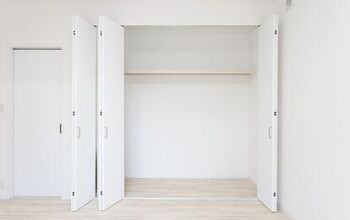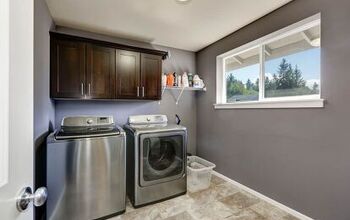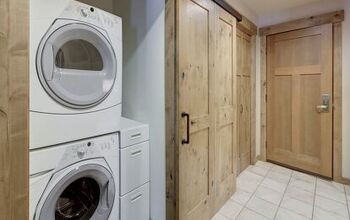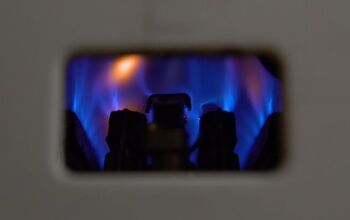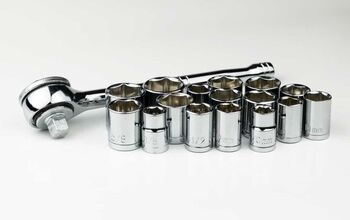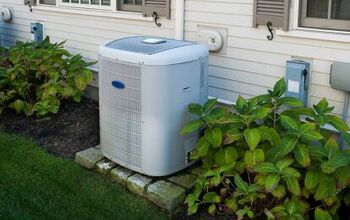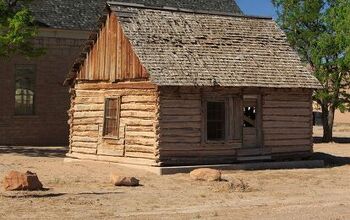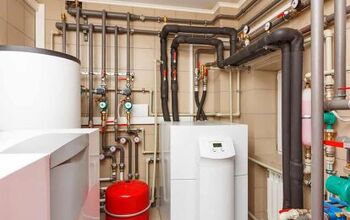Washer and Dryer Closet Dimensions (with Pictures)

Nowadays, most homes feature a place to do laundry, whether in a dedicated laundry room or shared space. The ideal laundry setup features adequate space for a washer and dryer, plus storage space and a work surface. However, when space is limited, a washer-dryer closet becomes a viable solution.
Laundry closets can vary in size depending on your available footprint, with one to four-unit styles the most common. One-unit laundry closets basically feature enough space for a stackable unit, about 3 x 3 feet. At the opposite end of the spectrum, four-unit setups are closer to 10 feet long, with ample storage and workspace.
The type of washer and dryer closet you end up with relies heavily on your available space. If you have some flexibility in that department, it’s worth familiarizing yourself with a few options. You can work with several configurations to find the one that works best for you.
Dimensions of a Washing Machine and Dryer
First things first, you need to know the average size of your laundry closet stars, the washer and dryer. After all, if you can’t fit the appliances, a laundry closet is pretty useless.
A standard washing machine measures roughly 27 inches wide x 31 inches deep x 39 inches tall. These measurements are for the appliance itself and don’t include a pedestal.
A dryer is usually similar in size to its matching washer since the two are often designed to be side-by-side. Typically, a standard dryer measures about 27 inches wide, 26 to 29 inches deep, and between 39 and 42 inches tall.
Of course, you can also find models both larger and smaller than these measurements. For example, if you need an extra-large capacity washer and dryer, they’ll feature larger exterior dimensions. However, for standard machines, they’ll mostly fall within these numbers.
Factoring in Clearance for a Washer and Dryer in Your Laundry Closet
In addition to your washer and dryer, you also need to consider the space necessary around the machines. You need to allow enough room in front (or above for top-load models) to load and unload the appliances. Plus, there needs to be adequate room behind them for things like electrical cords, hoses, and venting.
The Space Behind Your Washer and Dryer
It’s best to leave at least 5 to 6 inches behind your appliances for hook-ups and the dryer vent. This ensures nothing gets squished or cramped. You can also easily reach the valves if you need to shut off the water to or from the washer.
The Space in Front of Your Washer and Dryer Closet
When working with a laundry closet, you need to think about a few extra things. Besides needing space to access your machines, consider the closet doors.
Many laundry closets feature classic bi-fold doors which don’t allow access to the entire closet opening. When you push the door open, it takes up about 5 to 6 inches of space. This is why a laundry closet often needs to be wider than just the width of the machines.
Therefore, as a general rule, if working with a single-door closet, add 6 inches to your overall machine width. If using two bi-fold closet doors, add 12 inches, 6 to each side. Or, if space is at a premium, forgo doors altogether and hide your appliances with a stylish curtain.
With front-load machines, you also need to allow enough room in front of the closet to open the appliance doors. The door of a standard washer or dryer takes up approximately 22 to 23 inches of space when it’s open. Plus, you want to ensure you can load and unload the machines comfortably.
The Space Above Your Washer and Dryer
Many times, the space in the laundry closet above your washer and dryer is perfect for storage. You can install cabinets or shelving for cleaning essentials or hanging space for clothing.
But, if you have a top-load washing machine, make sure to leave adequate room for the open lid. Leaving roughly 18 inches of space clear above your washer lets you lift the lid and leave it open hands-free. Standard washing machine lids are usually about 16 to 17 inches deep.
However, measure yours specifically before mounting anything above your machines. If you don’t have a top-load washer, you can install a counter above your appliances, usually about two inches thick. This provides a stylish look while giving you lots of space to fold clothes, etc.
Now that you know the basics about the space you need, you can consider various washer dryer closet setups.
Laundry Closet Configurations and Dimensions
For a typical side-by-side washer and dryer, the minimum width is five feet, although five and a half is ideal. A standard washer and dryer take up about 54 inches when side by side. The minimum depth is 36 inches.
If you have more than 60 inches of width available, then you can add in more storage options and extras. Less than 60 inches, then you would need to consider smaller units or a stackable system.
Here is a look at some different laundry closet sizes.
One-Unit Laundry Closet
If you’re short on space but have a closet that is 3’0 x 3’0, you can make it work. All you need to do is install a stackable washer and dryer. Stacking two units reduces the overall footprint of your machines but takes up double the height.
This isn’t an issue if you have the standard 8-foot ceilings, but it is worth keeping in mind. You can purchase some systems designed to only stack. Other stand-alone models have stacking kits available to convert them into a stackable unit.
If you plan to go this route or think you might want to stack your machines one day, plan ahead. Make sure you get the appropriate stacking kit. Plus, buy it at the same time you get your units.
Stacking systems take up the same depth but half the width, so a 36-inch closet is certainly doable. If you have slightly less than 36 inches, opt for a curtain instead of a door. This swap can make accessing the machines easier.
Two-Unit Laundry Closet
The most typical washer-dryer closet is a two-unit setup. This layout gives you enough room for the machines, with some storage space above. You would need an area at least 3 feet deep and 5 feet wide to make this workable.
Below, you can see some possible layouts in a closet of this size. Of course, you have the side-by-side configuration, with two-foot cabinets above the appliances for storage. Or, you could opt for a stackable system and shorter upper cabinets.
This arrangement allows you space alongside the machines for a cabinet or shelving system and a worktop.
Three-Unit Laundry Closet
With the same depth of 36 inches but a width of 7.5 feet, a three-unit closet gives you ample storage space. Three units means space for three machine widths. In the example below, this translates to a side-by-side washer and dryer and a storage cabinet.
In this example, the washer is also a front-load, allowing for additional cabinets or shelves above the machines.
Four-Unit Laundry Closet
If you have a ten-foot closet to convert into a laundry area, then you can have the ultimate washer-dryer closet. This width gives you enough room for your washer, dryer, ample storage, and more. In this example, it allows for a set of cabinets with a countertop, complete with a small laundry sink.
The depth of the closet is still the minimum of 36 inches, and the height is standard 8-foot ceilings.
Related Questions
How do washer and dryer pedestals affect the dimensions of the appliances?
If you need extra storage space in your laundry area, pedestals under front-load machines can offer a solution. However, keep in mind they’ll give your appliances a boost, raising the height up to 15 inches. This extra height can make loading these machines easier. However, remember to account for the raised height when planning any storage areas above your machines. Also, if you use stacking machines, you won’t be able to use pedestals. A pedestal can’t support the weight of a stackable washer and dryer.
How much space do you need for a laundry room?
If you have the room to spare, laundry rooms can be a great way to make doing laundry more manageable. A basic laundry room is typically about 5 x 6 feet. This provides adequate space for both units, storage, hook-ups, and moving around the area. If you want to maximize the space in your laundry room, consider using stacking units to free up more floor space. If you have ample space, you can create a grand laundry room, complete with a sink, folding station, and more.
If you fear you don’t even have enough room for a laundry closet, don’t worry. There are smaller appliances available, usually designed for small apartments or RVs. These compact units are roughly 24 to 27 inches wide, 23 inches deep, and 34 inches tall.
Plus, they also come in stackable models. You can also look for all-in-one units that measure about 24 inches wide, 25 inches deep, and 33 inches tall. However, keep in mind, to compensate for the smaller footprint, expect more loads of laundry to complete all your washing.
Related Articles

Stacy Randall is a wife, mother, and freelance writer from NOLA that has always had a love for DIY projects, home organization, and making spaces beautiful. Together with her husband, she has been spending the last several years lovingly renovating her grandparent's former home, making it their own and learning a lot about life along the way.
More by Stacy Randall



